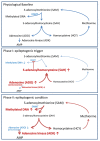Homeostatic control of brain function - new approaches to understand epileptogenesis
- PMID: 23882181
- PMCID: PMC3712329
- DOI: 10.3389/fncel.2013.00109
Homeostatic control of brain function - new approaches to understand epileptogenesis
Abstract
Neuronal excitability of the brain and ongoing homeostasis depend not only on intrinsic neuronal properties, but also on external environmental factors; together these determine the functionality of neuronal networks. Homeostatic factors become critically important during epileptogenesis, a process that involves complex disruption of self-regulatory mechanisms. Here we focus on the bioenergetic homeostatic network regulator adenosine, a purine nucleoside whose availability is largely regulated by astrocytes. Endogenous adenosine modulates complex network function through multiple mechanisms including adenosine receptor-mediated pathways, mitochondrial bioenergetics, and adenosine receptor-independent changes to the epigenome. Accumulating evidence from our laboratories shows that disruption of adenosine homeostasis plays a major role in epileptogenesis. Conversely, we have found that reconstruction of adenosine's homeostatic functions provides new hope for the prevention of epileptogenesis. We will discuss how adenosine-based therapeutic approaches may interfere with epileptogenesis on an epigenetic level, and how dietary interventions can be used to restore network homeostasis in the brain. We conclude that reconstruction of homeostatic functions in the brain offers a new conceptual advance for the treatment of neurological conditions which goes far beyond current target-centric treatment approaches.
Keywords: DNA methylation; adenosine; epileptogenesis; glial cells; homeostasis; ketogenic diet; mitochondrial bioenergetics and physiology; transmethylation pathway.
Figures


Similar articles
-
The Biochemistry and Epigenetics of Epilepsy: Focus on Adenosine and Glycine.Front Mol Neurosci. 2016 Apr 13;9:26. doi: 10.3389/fnmol.2016.00026. eCollection 2016. Front Mol Neurosci. 2016. PMID: 27147960 Free PMC article. Review.
-
Epigenetic changes induced by adenosine augmentation therapy prevent epileptogenesis.J Clin Invest. 2013 Aug;123(8):3552-63. doi: 10.1172/JCI65636. Epub 2013 Jul 25. J Clin Invest. 2013. PMID: 23863710 Free PMC article.
-
Role of adenosine in status epilepticus: a potential new target?Epilepsia. 2013 Sep;54 Suppl 6(0 6):20-2. doi: 10.1111/epi.12268. Epilepsia. 2013. PMID: 24001064 Free PMC article. Review.
-
Adenosinergic signaling in epilepsy.Neuropharmacology. 2016 May;104:131-9. doi: 10.1016/j.neuropharm.2015.08.046. Epub 2015 Sep 1. Neuropharmacology. 2016. PMID: 26341819 Free PMC article. Review.
-
Homeostatic control of synaptic activity by endogenous adenosine is mediated by adenosine kinase.Cereb Cortex. 2014 Jan;24(1):67-80. doi: 10.1093/cercor/bhs284. Epub 2012 Sep 20. Cereb Cortex. 2014. PMID: 22997174 Free PMC article.
Cited by
-
Comorbidities in Neurology: Is adenosine the common link?Neuropharmacology. 2015 Oct;97:18-34. doi: 10.1016/j.neuropharm.2015.04.031. Epub 2015 May 13. Neuropharmacology. 2015. PMID: 25979489 Free PMC article. Review.
-
Nucleic Acid Aptamers for Molecular Therapy of Epilepsy and Blood-Brain Barrier Damages.Mol Ther Nucleic Acids. 2020 Mar 6;19:157-167. doi: 10.1016/j.omtn.2019.10.042. Epub 2019 Nov 15. Mol Ther Nucleic Acids. 2020. PMID: 31837605 Free PMC article. Review.
-
Neuronal mechanisms of epileptogenesis.Front Cell Neurosci. 2014 Feb 21;8:29. doi: 10.3389/fncel.2014.00029. eCollection 2014. Front Cell Neurosci. 2014. PMID: 24600345 Free PMC article. No abstract available.
-
Ketogenic diets improve behaviors associated with autism spectrum disorder in a sex-specific manner in the EL mouse.Physiol Behav. 2017 Jan 1;168:138-145. doi: 10.1016/j.physbeh.2016.10.023. Epub 2016 Nov 9. Physiol Behav. 2017. PMID: 27836684 Free PMC article.
-
The potential role of DNA methylation as preventive treatment target of epileptogenesis.Front Cell Neurosci. 2022 Jul 22;16:931356. doi: 10.3389/fncel.2022.931356. eCollection 2022. Front Cell Neurosci. 2022. PMID: 35936496 Free PMC article. Review.
References
-
- Arch J. R., Newsholme E. A. (1978). Activities and some properties of 5′-nucleotidase, adenosine kinase and adenosine deaminase in tissues from vertebrates and invertebrates in relation to the control of the concentration and the physiological role of adenosine. Biochem. J. 174 965–977 - PMC - PubMed
LinkOut - more resources
Full Text Sources
Other Literature Sources

